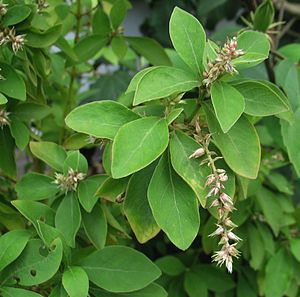Achyranthes mutica
| Achyranthes mutica | ||||||||||||
|---|---|---|---|---|---|---|---|---|---|---|---|---|

Achyranthes mutica |
||||||||||||
| Systematics | ||||||||||||
|
||||||||||||
| Scientific name | ||||||||||||
| Achyranthes mutica | ||||||||||||
| A.Gray |
Achyranthes mutica is a rare plant species from the foxtail family(Amaranthaceae). This shrub is endemic to Hawaii .
features
Achyranthes mutica is a multi-branched shrub that reaches a height of 30.5 to 60.9 centimeters. The opposite leaves are 3.3 to 4.1 inches long and 1.5 to 2.0 inches wide. The leaf stalks are 0.3 to 1.5 inches long. The surface of the young leaves is finely hairy, but becomes smooth as the leaves age. The leaf blade is obovate to elliptical or lanceolate.
The sessile flowers are arranged in spike- like inflorescences 0.4 to 1.5 centimeters long, hanging directly from the inflorescence axis covered with dense, downy, protruding hairs. Opposite the sepals is a 1 to 1.3 millimeter long, broadly egg-shaped bract , which is covered at the tip with fine spines. The broadly ovate bracts are 1.8 to 2.3 millimeters long. The petalless flowers are hermaphroditic. The 0.25 to 0.51 centimeter long sepals are asymmetrical and sharply pointed at the apex. Nothing is known about the fruit.
Achyranthes mutica differs from other species of the genus in the size of the sepals and the short and compressed ear.
habitat
Achyranthes mutica occurs at altitudes up to 925 meters in dry lowland forests in association with Acacia koaia , Dodonaea viscosa , Myoporum sandwicense , Nestegis sandwicensis , Osteomeles anthyllidifolia and Sophora chrysophylla .
Existence and endangerment
Before its rediscovery in 1992, Achyranthes mutica was only known of two specimens. The first was discovered in 1779 on the main island of Hawaii by David Nelson, a plant collector who worked for Joseph Banks . The second specimen, on the basis of which Asa Gray wrote the first scientific description in 1867, was collected by the French naturalist Ezekiel Jules Remy between 1851 and 1855 on Kaua'i . Today the species only exists at three localities on Hawaii in the region of the Keawewai Current, on the southern slope of the Puu Loa in the Kohala Mountains and in the Lanikepu Gorge. In 1997 the population consisted of 30 to 50 individuals. In the same year work began on setting up a seed bank with 500 seeds for Achyranthes mutica in the National Tropical Botanical Garden in Kalaheo . 20 plants were successfully grown in the cultivation. In 2003 the inventory had increased to 120 to 150 copies.
The main sources of risk are the degradation and destruction of the habitat by deer, livestock and feral goats. Landslides and hurricanes as well as competition with invasive plant species such as Psidium guajava , Ageratina riparia , Hylocereus undatus , Conyza bonariensis and Pennisetum clandestinum endanger the existence of the species.
literature
- Warren L. Wagner, Derral R. Herbst, SH Sohmer: Manual of the Flowering Plants of Hawai'i . University of Hawai'i Press, 1999 ISBN 0824821661
- Walton Beacham (Ed.), Frank V. Castronova (Ed.), Suzanne Sessine (Ed.): Beacham's Guide to the Endangered Species of North America. Beacham Publishing Corporation. December 2000. ISBN 0787650285
Web links
- Achyranthes mutica factsheet
- Achyranthes mutica in the endangered Red List species the IUCN 2008. Posted by: Bruegmann, MM & Caraway, V., 2003. Retrieved on 14 November, 2008.
- Entry at Natureserve